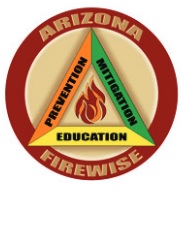 Is Your Landscape FireWise? - April 16, 2014 Jeff Schalau, Agent, Agriculture & Natural Resources University of Arizona Cooperative Extension, Yavapai County People living adjacent to undeveloped wildlands enjoy the solitude and closeness to nature. However, many of these settings are also wildfire-prone areas. Given our dry spring weather, fire departments and local governments are encouraging us to create and maintain wildfire defensible space. The two goals of wildfire defensible space are to reduce the vulnerability of your house and property to wildfire damage and make it safer for firefighters to defend your property should they be required to do so. Our goal should be to develop landscapes with design and choice of plants that create wildfire defensible space and enhance outdoor living space on the property. Defensible space landscaping integrates traditional landscape functions with a design that reduces the threat from wildfire. It includes planting for fire safety, vegetation modification techniques, use of fire safety zones, and other principles. When done thoughtfully, defensible space landscaping can also conserve outdoor irrigation water usage. Through proper plant selection, placement, and maintenance, we can diminish the possibility of ignition, lower fire intensity, and reduce how quickly a fire spreads, all of which increase a home’s survivability. FireWise plant selection is primarily determined by a plant’s ability to resist ignition thereby reducing wildfire threat. You should minimize use of coniferous evergreen shrubs and trees within 30 feet of a structure because these plants contain oils, resins, and waxes that burn with great intensity when preheated by an approaching fire. Use ornamental grasses sparingly here because they also can be highly flammable. Choose “fire smart” plants. These are low-growing plants with high moisture content. Their stems and leaves are not resinous, oily, or waxy. Deciduous trees are generally more fire resistant than evergreens because they have higher moisture content when in leaf and a lower fuel volume when dormant, and they typically do not contain flammable oils. Placement and maintenance of trees and shrubs are as important as actual plant selection. When placing trees in a landscape, remember the tree’s size at maturity. Keep tree limbs at least 15 feet from chimneys, power lines, and structures. Small specimen trees can be used near a structure if pruned properly and well irrigated. Defensible space landscaping can also include hardscaping: driveways, walkways, patios, parking areas, areas with inorganic mulches, and fences constructed of nonflammable materials such as rock, brick, or concrete. These non-flammable materials reduce fuel loads and create fuel breaks. Fuel breaks are a vital component in every firescape design. Water features, irrigated lawns, pools, ponds, or streams can be fuel breaks. Boulders and rock-covered areas can also be fuel breaks. Remember, while bare soil is an effective fuel break, it is not recommended for defensible space because of the potential for soil erosion, weed susceptibility, and other concerns. Homes located within chaparral vegetation or on south- or west-facing slopes pose greater risks and will require more extensive landscape planning for defensible space. Prevailing winds, seasonal weather, local fire history, and characteristics of native vegetation surrounding the site are additional important considerations. Slopes that go upward toward structures should have additional defensible space treatment as fire burns more aggressively when fuels are present on slopes. The 30 feet closest to the structure is the most critical defensible space area. This is an area where highly flammable fuels are kept to a minimum and plants are kept green throughout the fire season. Use cacti, succulents, and non-woody perennials here. Rock mulches are also good choices close to structures. Patios, masonry, or rock planters are excellent fuel breaks and increase wildfire safety. You can also be creative with boulders, riprap, and dry streambeds. Often, a representative from your local fire department or district can assist you with assessment of your property’s wildfire risk factors. The University of Arizona Cooperative Extension also has publications and information about creating and maintaining wildfire defensible space. Links to these have been included below. Follow the Backyard Gardener on Twitter – use the link on the BYG website. If you have other gardening questions, call the Master Gardener help line in the Camp Verde office at 928-554-8999 Ext. 3 or e-mail us at verdevalleymg@gmail.com and be sure to include your name, address and phone number. Find past Backyard Gardener columns or provide feedback at the Backyard Gardener web site: http://cals.arizona.edu/yavapai/anr/hort/byg/. Additional Resources Creating Wildfire-Defensible Spaces for Your Home and Property University of Arizona Cooperative Extension https://extension.arizona.edu/sites/extension.arizona.edu/files/pubs/az1290.pdf Fire-Resistant Landscaping University of Arizona Cooperative Extension https://extension.arizona.edu/sites/extension.arizona.edu/files/pubs/az1291.pdf Homeowners’ “Inside and Out” Wildfire Checklist University of Arizona Cooperative Extension https://extension.arizona.edu/sites/extension.arizona.edu/files/pubs/az1288.pdf A Guide to Creating Funtional and Attractive Survivable Space in Residential Landscapes University of Arizona Cooperative Extension, Yavapai County firewiseandwatersmart.pdf (two sided trifold brochure) Comparing the Ignitability of Mulch Materials for a Firewise Landscape University of Arizona Cooperative Extension https://extension.arizona.edu/sites/extension.arizona.edu/files/pubs/az1440.pdf |